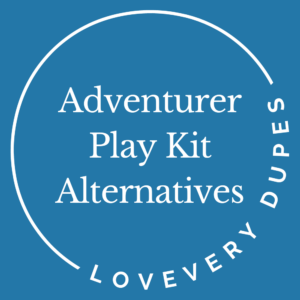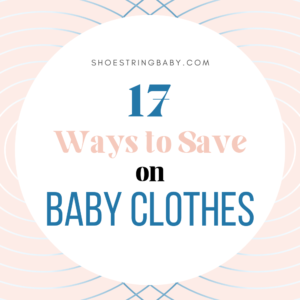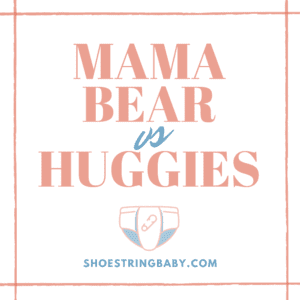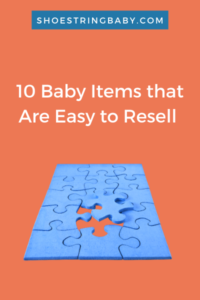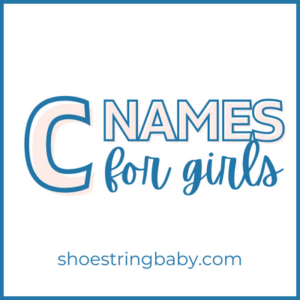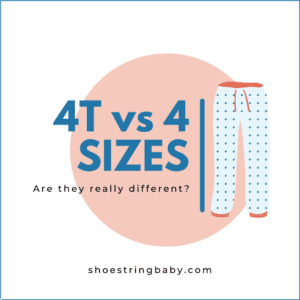Ultimate Pampers vs. Huggies Guide (Visuals & Real Testing)
This post may contains affiliate links. As an Amazon Associate, I earn from qualifying purchases. Read the full disclosure here.
Pampers vs. Huggies — who makes the better diaper? If you’re unsure how the two biggest names in diapers differ, then this analysis is for you.
This review is based on actual real life testing on our actual real life baby, which surprisingly can’t be said about a lot of reviews these days.
I’m a researcher by training and applied my analytic skills to make this the most detailed and rigorous Huggies vs. Pampers guide you’ll find.
Below you’ll find an in-depth comparison of our experience using both Pampers Swaddlers and Huggies Little Snugglers. The analysis breaks down the absorbency, size, comfort, fit, ingredients and cost of each diaper brand.
First and foremost, this review includes our absorption tests on each diaper. I photo documented everything and made gifs so you can personally see how well these diapers keep babies dry.
We also used hundreds of these diapers on our baby as a “field test”, including multiple overnight tests.
Now, let’s compare some diapers.
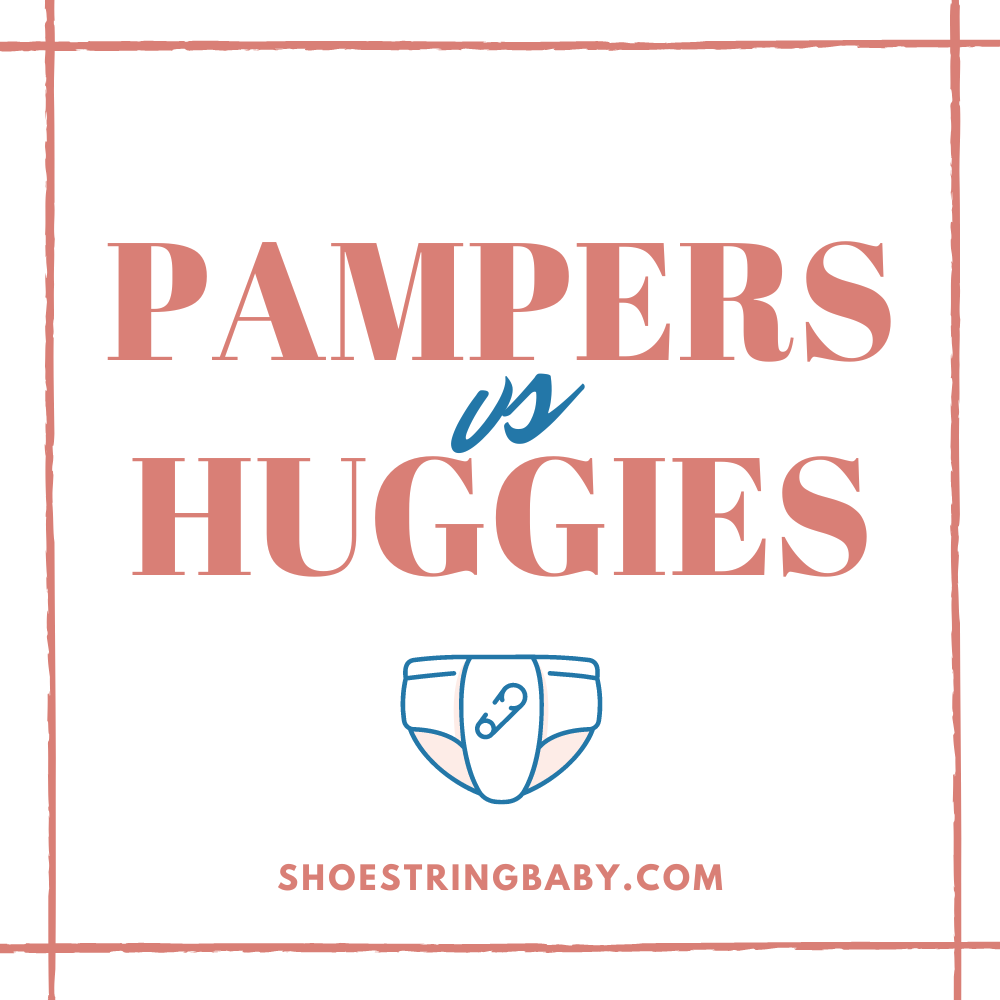
Key Points of Huggies vs. Pampers Diapers
No time to read the whole article? Here are the key differences between Huggies vs Pampers:
- Pampers and Huggies absorb liquid equally well.
- Huggies are fragrance-free; Pampers are not.
- Huggies performed better overnight than Pampers.
- Pampers and Huggies are priced similarly.
- Pampers bifurcates their absorbent layer into channels for added comfort.
- Huggies adds blowout catching pockets and grip strips for more security.
- Pampers and Huggies are similarly sized.
So, are Huggies or Pampers better? They perform similarly well on absorption, but Huggies are fragrance-free and did better overnight. That said, you’ll likely be happy with either of these premium diapers.
Note: I specifically tested Pampers Swaddlers and Huggie’s Little Snugglers for this write up.
Size
The diapers tested here were size 2, which have a weight range of 12-18 lb in both Pampers and Huggies.
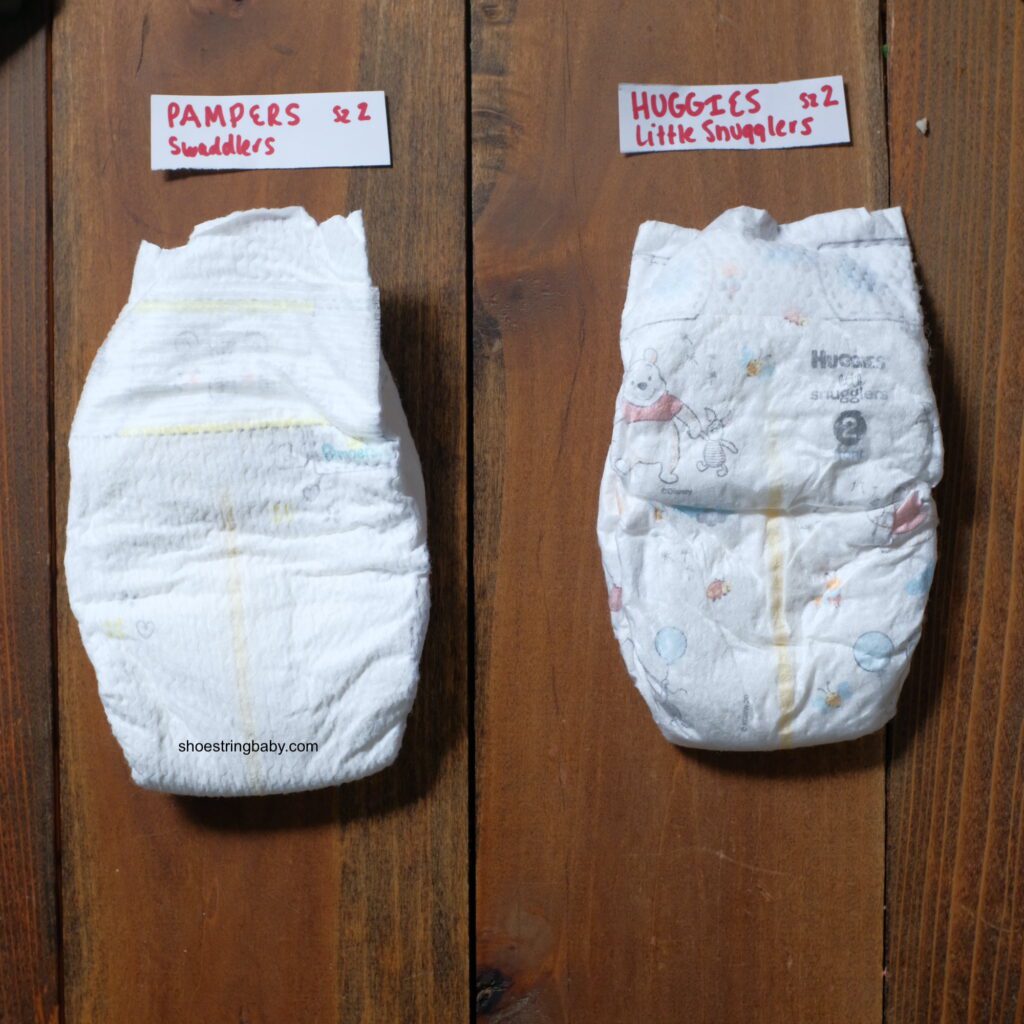
Pampers Swaddlers run a bit bigger than Huggies Little Snugglers.
Here are the measurements of both diapers:
| Size 2 Measurements | Huggies Snugglers | Pampers Swaddlers |
| Height | 7″ | 7.25″ front, 8″ back |
| Width | 4.5″ | 5″ |
| Between Legs | 3.25″ | 3.5″ |
| Front waistband | 9″ | 10.5″ |
| Velcro Strip | 7.75″ | 4.5″ |
| Back waistband | 9″ | 11.5″ |
| Back waistband stretched | 12.5″ | 13.5″ |
Pampers Swaddlers diapers go from newborn size (up to 10 lb.) to size 7 (above 41 lb.). Huggies offers their Little Snugglers from newborn (up to 10 lb.) to size 6 (over 35 lb.), and their Little Movers diapers up to size 7 (above 41 lb.).
Both Pampers and Huggies offer preemie sized diapers. Each company offers three sizes of preemies to accommodate down to micro-preemies.
(Update: thank you very much to reader Abby who sent me info on Huggie’s preemie offerings! I had incorrectly said they only had one preemie size when in fact they have three. Huggies details their preemie offerings on their healthcare site instead of their main website).
WINNER: TIE — Pampers and Huggies both makes diapers available from the smallest preemies to size 7 for kids who may need diapers longer. I appreciate this accessibility of both brands.
I personally like a diaper that runs larger because of cost savings, since cost per diaper increases when you size up, but this is a personal preference.
Absorbency Testing
Below you’ll find the results of the absorption experiments we ran on the Huggies and Pampers. I animated each test so that you can visually see the diaper performance.
The info box below provides our experimental method for those interested in the details:
TESTING METHOD
To test the absorption of Huggies versus Pampers, we poured 350 mL of liquid on the diapers in 50 mL increments (roughly an infant’s bladder capacity). 350 mL approximates a daily urine output for an average 9-month old, assuming 2 mL of urine per kg of body weight per hour (source, source).
To test absorption efficiency, the diapers were tested for wetness after 25 seconds using a paper towel. Photos were taken every five seconds after each pour to visualize absorption.
At the end of the test, diapers were left to rest for approximately 10 minutes to see how well they continued to absorb and dry out.
Pampers Absorption Test Results
Pampers: Pampers had interesting results in the absorption tests. Overall, Pampers Swaddlers are impressive in their absorption efficiency and capacity.
They performed the best of all diapers tested at higher volumes.
However, even on the first pour of liquid, Pampers had beads of liquid stay on the diaper. To the touch, the diaper seemed very dry other than these liquid beads.
The beads left wetness on the paper towel. Interestingly, once we hit about 250 mL, there was actually less liquid beading up than the first few pours.
Here is the visualization of the test:
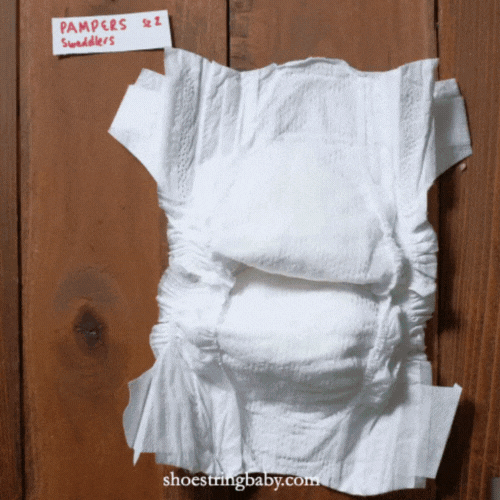
I have to imagine that in real life this beading issue would be mute because a baby’s movement would force these beads into the diaper quickly.
At the end of the test after a resting period, the Pampers were dry on the final paper towel test but felt very slightly damp to my skin when I cut the diaper in half.
Huggies Absorption Test Results
Huggies: Huggies diapers really shone on the first three pours of the absorption test.
In fact, they did the best job and had the quickest absorption of all the diapers we tested in this trial.
It was the only diaper that had completely dry paper towel tests after 25 seconds at 50 mL and 100 mL, and only the slightest dampness at 150 mL.
Here is the visualization of the test:
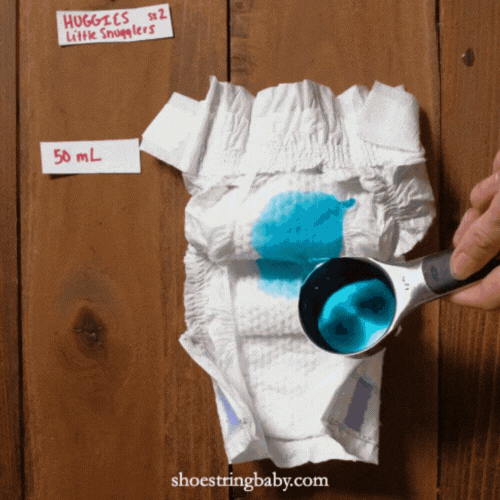
By 200 mL the paper towel test had wetness and the performance was comparable to Pampers at the same volume.
I was not able to rest the Huggies’ diaper quite as long as the Pampers before cutting it in half because our baby’s patience had run out. Because of this, you may notice slight dampness on the photo of the paper towel test.
However, I felt it again after the photos and it felt very slightly drier to the touch than Pampers.
WINNER: TIE — Both diapers performed very well during testing. Huggies won the initially pours with impressive absorption efficiency.
Pampers had the edge after the 250 mL mark for maintaining absorption under higher volumes.
This will come down to whether you prioritize quick absorption or higher capacity performance.
Overnight Testing: Huggies vs. Pampers
Pampers: In terms of holding pee well overnight, Pampers performs equally well to Huggies.
Sometimes the diaper shell would have some dampness but not enough to wet clothes, and our baby’s skin was never irritated by wetness.
However, I frequently noticed a urine smell in the morning. This happened on many occasions and is the only diaper brand we’ve used with noticeable odor after an overnight.
This result surprised me since it is the only diaper tested that actually includes fragrance. The smell ultimately led us to only use Pampers during the day.
Huggies: Huggies have been great for us as an overnight diaper. Overall, we’ve had very minimal leaking issues.
Sometimes they will feel slightly damp on the outer shell in the morning but not enough to wet the clothes, and our baby’s hasn’t been irritated by overnight moisture.
WINNER: Huggies — Huggies have been very reliable for us on overnight tests without any smells vs. Pampers’ odor.
Related Post: Hello Bello Overnight Diaper Review
Cost
Pampers and Huggies are both name brand diapers and cost accordingly. Their prices are comparable.
Both Pampers and Huggies cost is roughly double what you’ll pay for a store brand diaper (varying a little depending on the store brand).
Since prices and sales fluctuate constantly, you can check current prices for both diapers here:
WINNER: TIE — Huggies and Pampers costs are essentially the same
Manufacturing Location
Both Pampers and Huggies are made in the U.S.A.
Ingredients of Huggies Little Snugglers vs Pampers Swaddlers
Pampers and Huggies diapers are fairly comparable on the ingredients they share.
The difference that will matter to most people is that Pampers uses fragrance in their diapers while Huggies is fragrance free.
Huggies also does a nicer job of explaining why they include each ingredient in the diaper on their website.
| Huggies | Pampers | |
| Fragrance Free? | YES | NO |
| Chlorine Free? | Elemental | Elemental |
| Latex Free? | YES | YES |
NOTE: Elemental chlorine free means that no direct chlorine was used, but other chemicals used in the wood bleaching process may contain chlorine. Chlorine is a concern because of the environmental impact and possible exposure to dioxins.
Pampers: Pampers Swaddlers contain: pulp, a polymer, light fragrance, polypropylene, polyethylene, polyester.
Huggies: Huggies Little Snugglers contain: wood pulp, polypropylene, polyethylene, polyurethane elastics, polyolefin elastic, adhesives, colorants, printing ink, sodium polyacrylate (absorbent material), polyester, and a color-changing wetness indicator.
WINNER: Huggies — Huggies beats out Pampers by being fragrance free and more detailed with their ingredients list information.
Comfort of Pampers vs. Huggies
Softness: Both diapers are velvety soft but the Huggies are slightly softer than the Pampers.
The Huggies elastics around the legs are also very soft and light, which is a nice comfort touch for the baby’s legs.
Bulkiness: Both diapers bulk up considerable with the introduction of liquid.
Pampers Swaddlers, though, divides its absorbent filling which is a premium feature that the Huggies lack.
This division helps keep the absorbent filling in place and reduces the chances it’ll bunch up with movement.
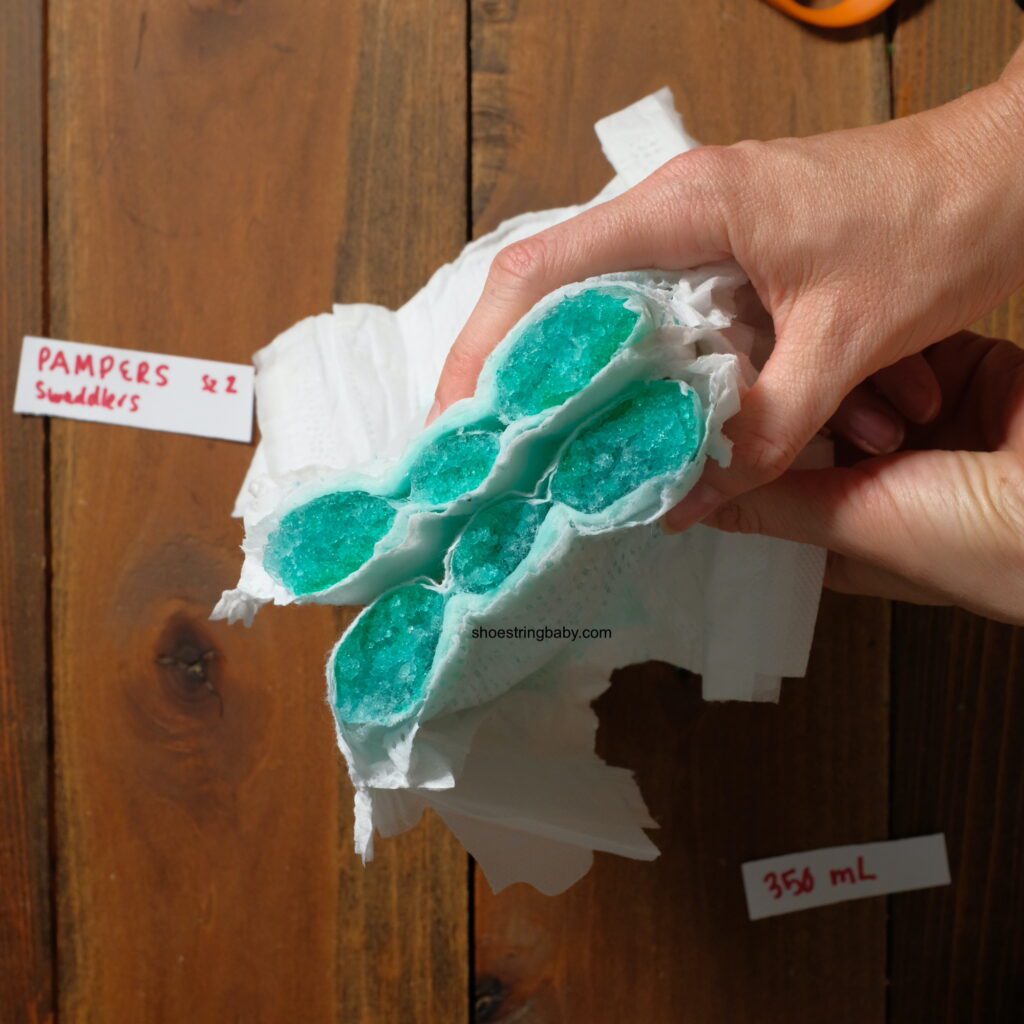
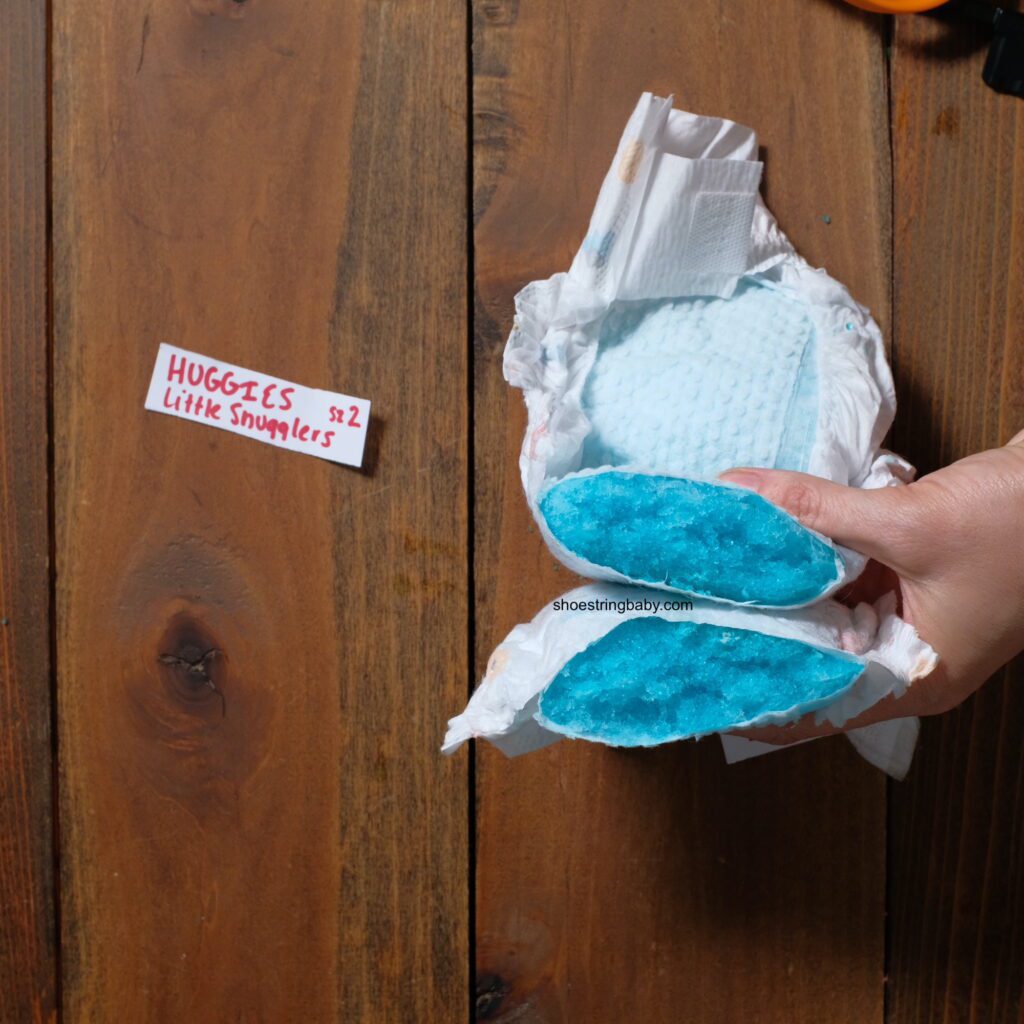
This bifurcation of the absorbent filling is one of the biggest differences between Huggies and Pampers.
Umbilical Cord Space: Both Pampers Swaddlers and Huggies Little Snugglers newborn sizes have space for the umbilical cord.
WINNER: Pampers — The bifurcation of the inner filling is a very nice touch by Pampers.
Fit & Secureness of Pampers vs. Huggies
Fit: Huggies Little Snugglers fit slightly smaller than Pampers Swaddlers. I was able to get a secure fit with both diapers but diaper fit does depend some on your baby’s proportions.
Waistband: Huggies diapers have elastic in the waistband while the Pampers do not. The elastic is nice because it provides a little more flexibility when fitting the diaper.
The Huggies Little Snugglers diapers also have a thoughtful added feature of a pocket in the back of the waistband to help catch blowouts (pictured below). This is a nice touch that gives the Huggies a more premium feel.
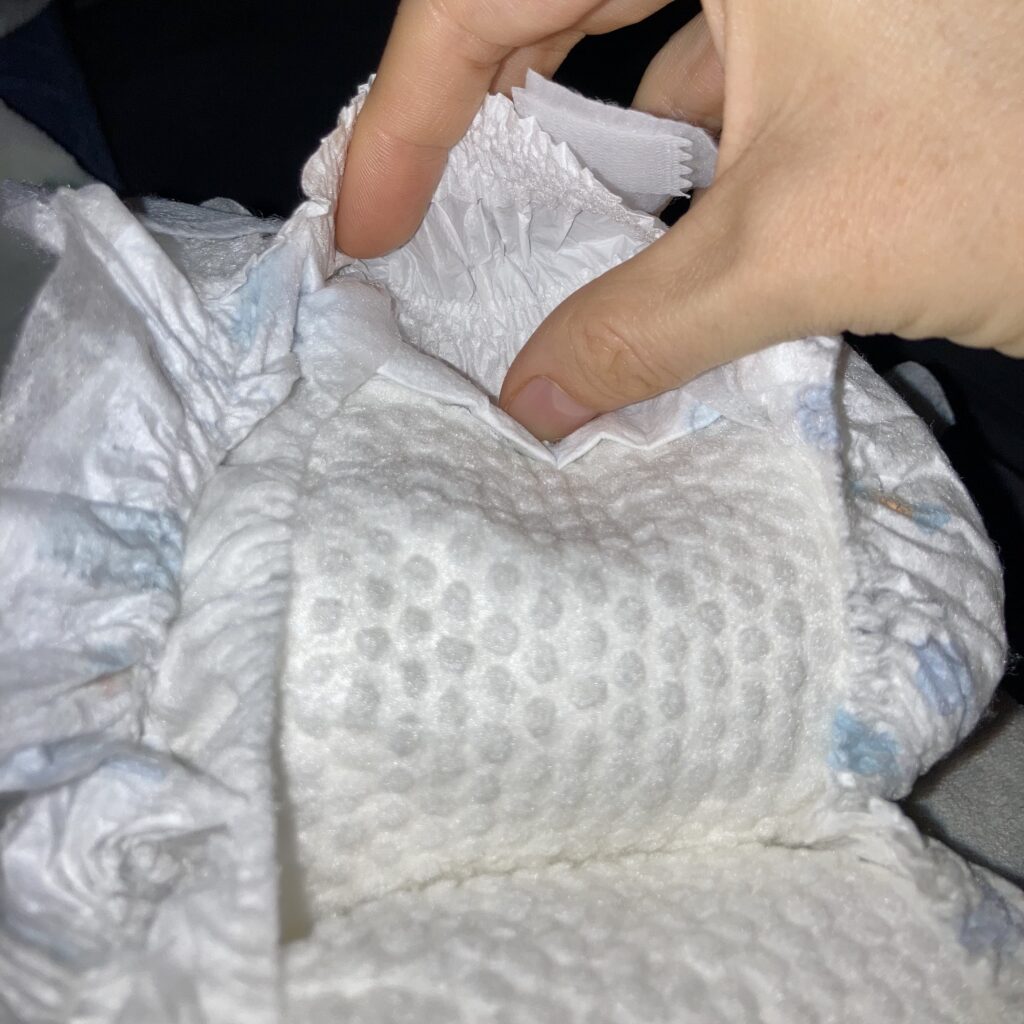
Tabs: The tabs on the Huggies and Pampers diapers are fairly comparable. They have some stretch but are not overly stretchy.
Sturdiness: We had no issues with either diaper staying on and staying in place as our baby crawled around. The Huggies adds an extra feature called “grip strips” to add more security to the tab fastening.
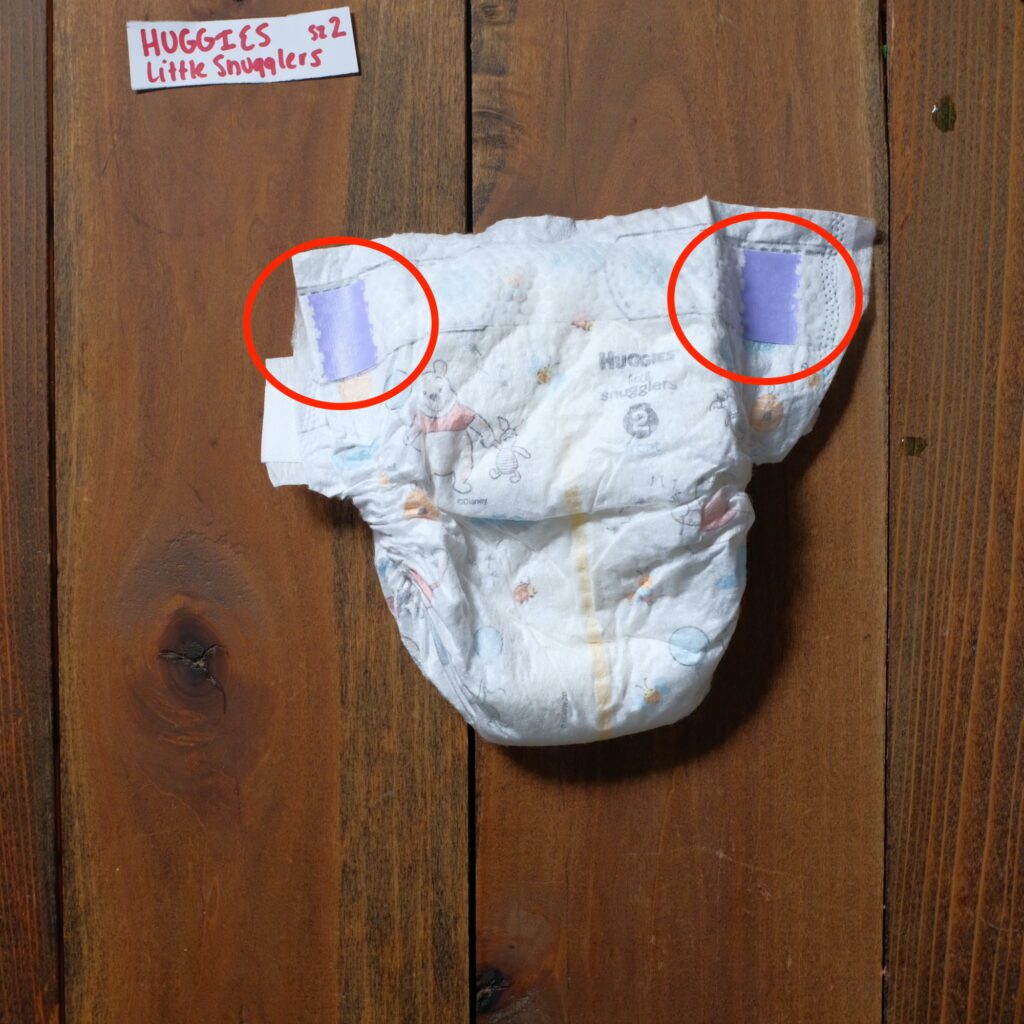
While I can appreciate the effort to add improvements to the diaper, I personally disliked these purple grip strips (pictured above in the red circles).
We often have to adjust and refasten the tabs as we diaper a wriggly baby and the grip strips made this more difficult. They also seemed to pull the material when we opened and re-closed the tabs.
Different parts of the diaper would also attach to the grip strips which made diaper changing one handed while trying to pin down a baby more difficult.
Overall, the grip strips seem to be a good idea in theory but not in practice.
WINNER: Huggies — The grip strips are not my favorite but I have to credit Huggies for adding premium features. The elastic waistband and back pocket for blowouts give Huggies the edge vs. Pampers.
Look of Huggies vs. Pampers Diapers
Wetness Indicator: Both Huggies and Pampers diapers have wetness indicators.
Size Up Indicator: Neither Pampers nor Huggies have clear instructions on their size up indicators.
Pampers have markings on their waistbands that they call “fit guides” but I did not easily find instructions on how to interpret them on our box.
Similarly, the Huggies website says some of their diapers include images where the tabs fasten that function as size up indicators but doesn’t say which models. Once the picture is visible, it is time to size up.
There were small circles on the Huggies waist bands I reviewed; however, I couldn’t find any information on Little Snugglers specifically to confirm that these are the indicators (presumably they are).
Design: Pampers diapers have a more simple aesthetic vs. Huggies’ Disney branding. The Huggies I reviewed had Winnie the Pooh characters on the outer shell.
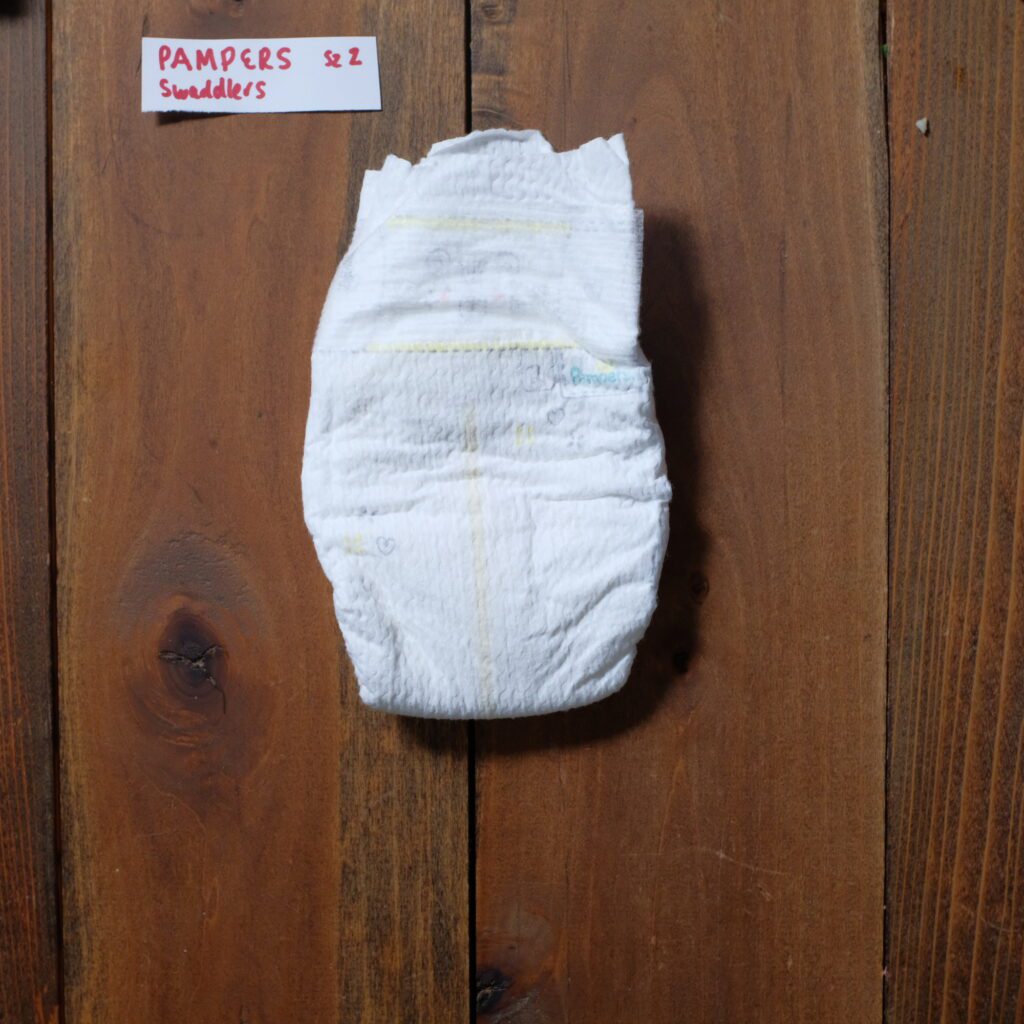
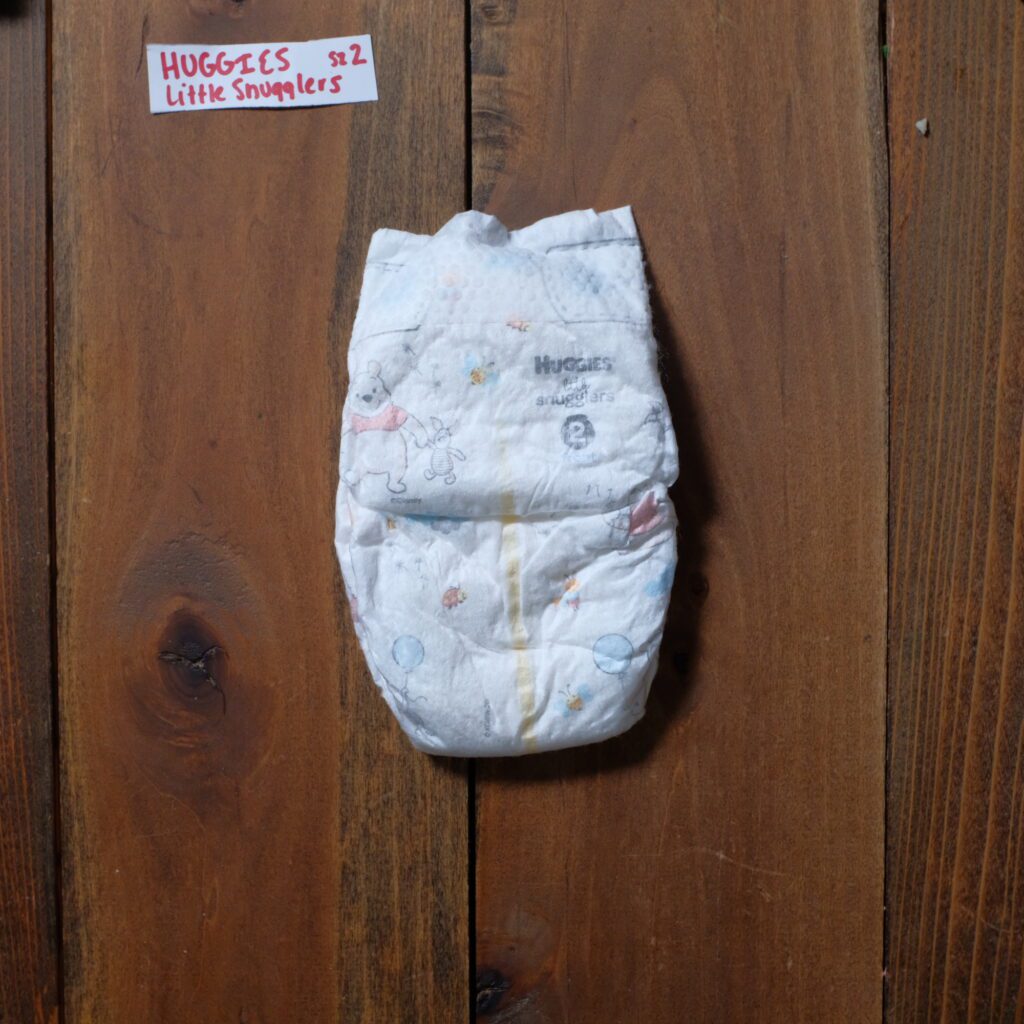
WINNER: TIE — The look of the diaper will come down to personal preference.
Conclusion: Are Huggies or Pampers Better?
So, which is better: Huggies or Pampers? Honestly, they’re very comparable and the small differences will likely come down to personal preference.
| Pampers | Huggies | |
| Size | TIE | TIE |
| Absorbency | TIE | TIE |
| Overnight | — | WINNER |
| Cost | TIE | TIE |
| Ingredients | — | WINNER |
| Comfort | WINNER | — |
| Fit & Secureness | — | WINNER |
| Look | TIE | TIE |
| Manufacturing | USA | USA |
In terms of absorption, Huggies had the best early absorption efficiency of any diaper brand I’ve tested to date.
The diaper was dry to the touch only 25 seconds after the first few pours of liquids. It is a reliable diaper overnight and has many of the thoughtful design elements of a luxury diaper.
Pampers also had solid absorption and really shone at the highest volumes. They cleverly divide up their absorption filling to prevent bunching and bulkiness. The one negative for us was their overnight performance.
If you found this review helpful and decide to buy Pampers or Huggies, I’d appreciate it if you considered using my affiliate links: Pampers diapers and Huggies diapers. Affiliate links are at no cost to you and help support my time writing these in-depth comparisons.
That said, the question remains whether these diapers are worth the additional cost. Both cost almost double the price of most store brand diapers. Do they actually provide twice the value?
Over a year of diapering, name brand diapers will cost you hundreds of dollars more (~$300/year) than their store brand alternative.
At the end of the day, disposable diapers end up in the trash. To me, neither Pampers nor Huggies revolutionize the diaper game enough compared to store brands to justify the cost difference.
Don’t worry, I’ve also compared both Pampers and Huggies to common store brand diapers so you can see for yourself:
Read More:
Don’t forget to check out some of my other diaper comparisons, like Pampers vs. Hello Bello Diapers. For Huggies comparisons, explore my guide to Huggies vs. Mama Bear Diapers.

